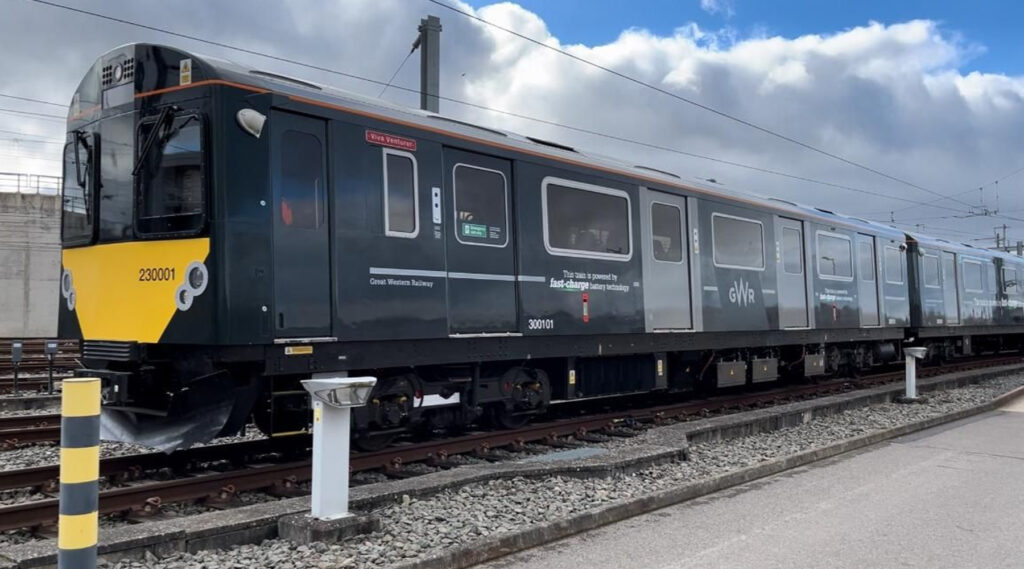The new battery train starting service in west London shortly has set a new UK record, after travelling 86 miles (138km) on battery power alone and without recharging.
The train had been undergoing tests in Long Marston in Warwickshire, and made the 70-mile move to GWR’s Reading Train Care Depot last Friday – using just 45% of its battery capacity. The trip was significant as it wasn’t an idealised test scenario, but a real-world environment, at speeds of up to 60mph, stopping and starting over a hilly route, with elevation changes of up to 200m.
Now that the train is at Reading, it will undergo compatibility testing and preparedness for future maintenance and servicing requirements.
GWR Engineering Director Dr Simon Green said: “We were delighted by how the battery train performed today and during its series of test runs. In fact, it’s fair to say it has surpassed the expectations of our team of engineers.”
The train exceeded the 84 miles (135km) recorded by a Stadler Class 777 under test conditions in 2022 – believed to have been the greatest distance travelled by a battery train designed for the UK.
GWR’s FastCharge technology has been designed to solve the problem of delivering reliable, battery-only trains capable of fulfilling timetable services on branch lines, eliminating the use of diesel fuels.
The use of batteries for extended operation has typically been constrained by their range and meant widespread implementation has, until now, not been possible. It also negates the need for overhead electric lines which are expensive, time consuming to install and impact the landscape.
At West Ealing, where the technology will be trialled in a real-world environment for the first time this spring, the train will charge for just 3 ½ minutes before restarting its journey on the Greenford branch line.
Charging rails and lineside battery banks have been installed at West Ealing in preparation for the start of the trial on the Greenford branch line. Once the trial commences it will run in non-passenger service alongside scheduled passenger services.
GWR has already carried out simulations on other branch lines in the Thames Valley to explore how it could be rolled out even further in the future. It is hoped the technology could one day see battery-powered trains in operation across the UK’s approximately 2,000 miles of 80-plus branch lines.








Why bother with slow battery trains….just electrify all railways. That will reduce pollution from diesel trains on all networks. This battery train is just someone’s pet project.
I imagine that cost is the main reason why electrifying all lines is unlikely to happen, at least not within the next decade.
Electrifying lines requires the installation of substations along the route, which also need to be connected to the National Grid. It may also require some bridges along the route to be demolished and rebuilt, in order to accommodate the overhead wires.
Theses costs of implementing electrification may be harder to justify for smaller branch lines. Therefore battery trains with fast charge may provide a quicker and more affordable solution for now.
The St Ives Bay branch line at just 4.25 miles seems like another ideal candidate for using battery trains instead of diesel.
Really makes sense to me. To put up overhead power lines on some of these country routes would be sacrilege. Some of the Cornwall lines would benefit as would the Basingstoke to Reading shuttle.
A tentative step by Network Rail towards economical and sustainable electrification of the whole system. It will be a long developmental process that will also include the next step, via DOO trains and finally a driverless system.
The Unions will of course still be fighting in their futile striking manner, that already alienates them from the general public, against constantly improved technology and societal changes. The rest of us call it progress!
Railway electrification costs £1-2 million per single track kilometre. It might pay off in lower running costs on a well used mainline but no chance on lightly trafficked lines.
Mersey Rail in Liverpool have been using battery powered trains for some time.
Not successfully, they cannot fully utilise the 777s and are refunding passengers due to not being able to provide a full service